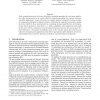Free Online Productivity Tools
i2Speak
i2Symbol
i2OCR
iTex2Img
iWeb2Print
iWeb2Shot
i2Type
iPdf2Split
iPdf2Merge
i2Bopomofo
i2Arabic
i2Style
i2Image
i2PDF
iLatex2Rtf
Sci2ools
CMG
2004
2004
Quality of Service Aspects and Metrics In Grid Computing
Grid computing promises to become the future computing paradigm for enterprise application after having shown to be a quite effective computing paradigm for resource-intensive scientific applications. Large scale grids are complex systems, composed of a large number of components belonging to disjoint domains. Planning the capacity to guarantee quality of service (QoS) in these environments is a challenge because global Service Level Agreements (SLA) depend on local SLAs, i.e., SLAs established with components that make up the grid. These components are generally autonomous and join the grid as part of a loose federation. This paper investigates some of the relevant issues that must be considered in designing grid applications that deliver appropriate QoS: definition of metrics, relationship between resource allocation and SLAs, and QoS-related mechanisms.
| Added | 30 Oct 2010 |
| Updated | 30 Oct 2010 |
| Type | Conference |
| Year | 2004 |
| Where | CMG |
| Authors | Daniel A. Menascé, Emiliano Casalicchio |
Comments (0)

